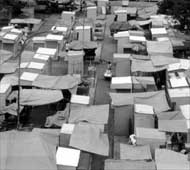
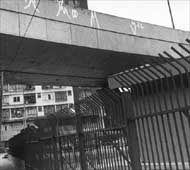
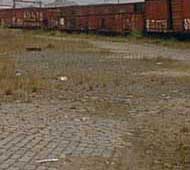
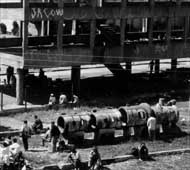

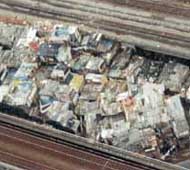
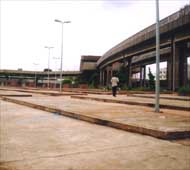
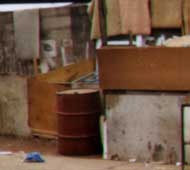
Notion
of field, instead of form.
Um field is not made of units, but of moving directions. It does not have
beginning nor end, but middle, through which grows and overflows. In
contrast to a structure, which is defined by a set of points and positions,
the field is made only by lines (of stratification, but also of
deterritorialization). It proceeds by variation, expansion, conquest,
capture. It is an a-centered, non-hierarchic and non-significant system.
A body is not made of partial objects, but of differential speeds. Plan where things only distinguish themselves through speed and slowness, movement and rest, the retardation or rapidity that compose them. Speed and slowness not only subordinate the structure form, but also the types of development. In this plan move the non-formed elements that are only distinguished by the speed and enter in definitive arrangement in function of its connections, of its relations of movement.
The question is not of organization, but of composition. To think a world covered by informal elements of relative speed, infinite parcels of an impalpable substance that enter in variable connections. A diagram: a composition of speeds and affectations on this field, different from the plan of the forms, substances and subjects. The static relation form-substance opposes the dynamic relation material-forces.
Spaces in the East Zone
1 intervals
2 differentials of speed
slow spaces
railroad,
deindustrialization, cereal wholesale zone
fast spaces
road system, new enclaves
3 railroad areas
pari until mooca
4 unstable population occupation
parque d. pedro / largo do glicério / brás station
5 informal occupation
largo da concórdia / av. celso garcia
6 zone
parking
lots, warehouses
7 speed
av.
radial leste / av. salim farah
Territory is an operation of demarcation of distances. But the critical distance is not a measure, is a rhythm. Another schema is announced here: in network. Not a form or structure, but an articulation. A fluid ensemble, without linear evolution, but densifications, intensifications and dividing acts. Intervals, distributions of inequalities and emptiness. Overlapping of different rhythms, without imposition of measure.
That’s how the smooth space infiltrates the polis, a grooved space. It works distributing itself through the space, taking the space, keeping the possibility to appear at any point. The movement does not go from a point to another, but it is perpetual, without origin or destination.
The smooth space is the one of small interval, of infinitely close points. A space of small contact actions, tactile, not visual. A field without conductors or channels. Decentralized multiplicities, non-metric, occupying the space without measuring it. They cannot be visually observed from a point outside their space. The smooth space is a milieu without horizon, as the desert or the sea. They’re in no intermediate distance, perspective or contour.
Amorphous, informal space. The interval takes everything. In the smooth space, the line is a vector, a direction, not a dimension or metric determination. A space constructed by local operations with directions changes. Directional, not dimensional space. Occupied more by events than by forms. Space of affectations, where materials designate forces. Intensive more than extensive, of distances, not measures.
The smooth space does not hold deep nor contour, but directional changes and connections of local parts. Abstract line of variation, in band, spiral, S and zigzag, that escapes from geometry, without tracing contour or delimiting form. How the space, continuously grooved, develops other forces and arises new smooth spaces?